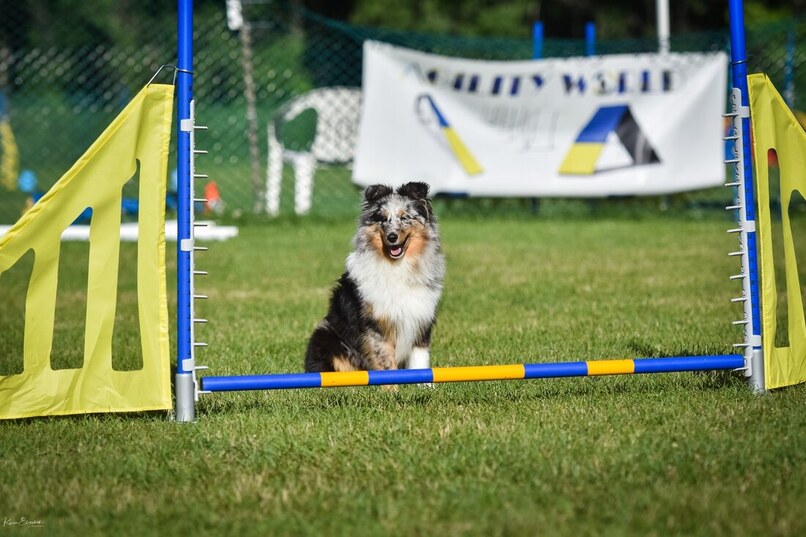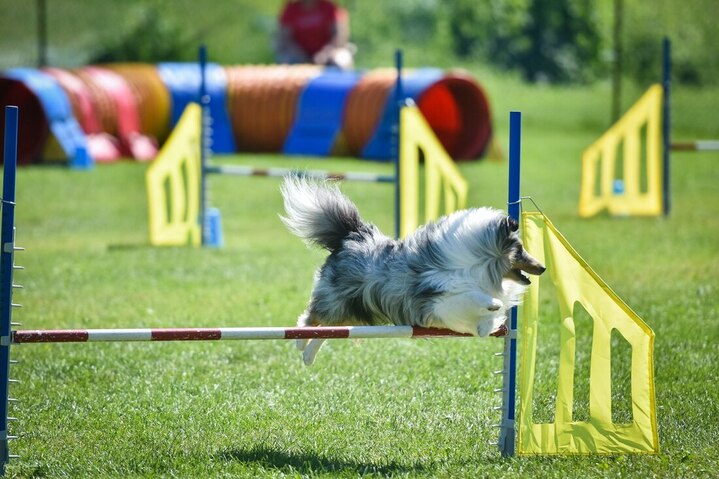|
We ask a lot of our sporting dogs so as owners we also have to do a lot of groundwork to prepare them for the physical challenges they'll face. Think of an agility run and the types of physical demands we place on our dogs. As trainers, we'll often drill our dogs on contacts, weave performance, and distance work but how often are we dedicating time to jumping form? In a single agility run the jump is the most common piece of equipment your dog will see. Think of how many jumps they might complete over a two day competition? The reality is we often take advantage of our dog's natural ability to jump and can neglect to put in the same amount of training for the jump performance as we do for their weave or contact performance. This week, I break down the complex topic of jumping! The Truth about JumpingAll dogs, either your sporting or pet dog, are terrific athletes with a natural affinity for jumping. Because it is so natural for dogs to jump over or onto things (e..g couches, cars, our arms, beds), those of us who compete in canine sports like agility or obedience sometimes take jumping for granted, meaning, we don’t spend as much time on teaching our dogs to jump efficiently and safely. Think back to your last training session and what you dedicated your time to - was jumping really considered in your set up? Now think about the type of jumping demands sports like agility asks of our dogs. Our dogs have to navigate a variety of jumps at challenging angles and heights and do it quickly and cleanly. Jumping can put a lot of stress on our dogs bodies. Unlike humans, whose spines are designed for compressive force, dogs aren't designed to walk upright and their discs cannot handle compressive load as well. Over time, cumulative stress and repetition can sideline our dogs. Keeping our dogs in peak physical condition is key to helping them have the ability to adapt to various jumping skills and to become successful jumping dogs! The Stages of a JumpFor your dog to jump they must engage their entire body. A jump performance has five stages and during each stage your dog's body will use different parts of the body to accomplish each step.
Jumping styles will tend to vary by breed and individual, but the sequence of events and how your dog's body is used is essentially the same. To become a great jumper, you need to give dogs the time to develop their skills as they will each progress at their own pace. Many dogs will not achieve their full jumping potential until after they begin competing. How Your Dog's Structure Plays a Role in JumpingYour dog's structure can greatly effect the way they jump. Generally, we can split dogs into three categories
If your dog has had their tail docked (full or partial) their jumping ability can also be affected. Your dog's tail assists with making sharp turns, initiating movement and helping with balance. Dogs with docked tails are at a disadvantage particularly when jumping at their max height when rapid changes of direction are required. A shorter tail will require the dog to make greater compensation through the rear limb movement and spine flexibility; dogs without tails will jump differently. Another factor that can affect you dog's jumping is whether or not they have front dewclaws. Front dewclaws are a functional digit and when your dog moves faster than a trot their dewclaw will touch the ground. Check out my previous blog for more information on the function of dewclaws. If a dog does not have dewclaws, there is a higher potential for the carpal ligaments to stretch and tear which could result in laxity and arthritis over time (OUCH!). This can then result in more stress being generated through the dog's carpus, elbow, shoulder, and spine as it tries to compensate for the lack of digit. Regardless of which type of dog you have, consider their strength and weaknesses of each and what you might change in your training routine or conditioning to minimize injury and load. Other Factors that Influence Jumping
What is Considered Good Jumping?When it comes to jumping our dogs will often decide what is best for them but as handlers we generally want to see a couple things.
Conditioning our Dogs to be Better JumpersGood jumpers aren't born - they're made and there is a number of things we can do to help our dogs become better jumpers! When training we need to be more mindful of including jump mechanics into our sessions and focus on areas that will strengthen the parts of the body that are primarily used in jumping. This means, for conditioning, we should focus on the hind limbs, the front limbs, and the core. Keep in mind that we have to provide conditioning exercises to match the movements of jumping. The body adapts to imposed demands so we'll need to incorporate physical training that mimics the motion and actions we expect our sport dogs to perform and create exercises that replicate those movements. This is known as the Specific Adaptation to Imposed Demands (SAID) Principle. Break down the jumping movement into pieces and work to strengthen each piece. Also, remember, that in order to improve athletes must continually work harder as their bodies adjust to the workout. This is called the Overload Principle. Once your dog understands how to do an exercise, you cannot just continue doing it the same way again and again. Rather, exercises must continually be progressed to increase challenge to the body. When and how to progress the exercise depends on the dog, but generally an exercise should be progressed every 4 to 12 weeks.
Remember, that while jumping can take a physical toll on our dogs there are lots of things we can do to help them. By keeping our dogs physically fit and taking into account how their structure can help or hinder them we can better prepare them for the demands of sport. If you need more guidance on how to help your dog become a better jumper I'm always happy to provide advice!
5 Comments
Kathie
6/19/2020 04:01:11 pm
Excellent information. I’m going to look at my videos differently now - with more purpose
Reply
Carolyn McIntyre
6/21/2020 07:49:10 am
So glad you found this week's blog helpful Kathie! Videoing is such a great tool!!! Let me know how it goes!
Reply
Mary
1/31/2021 12:47:02 pm
Nice article. Where can I find good exercises to make my dog a better jjumper? She takes off too early occasionally and I believe it’s because she is not confident. Thanks for any info
Reply
Christiana Simpson
1/28/2022 12:25:08 pm
This is all great info I love reading your blogs. What exercises can I start out with to help my dogs be better jumpers?
Reply
Erin
1/29/2022 12:15:45 pm
My corgi has both a docked tail and his dew claws removed. Is there anything I can do to help him compensate for this?
Reply
Leave a Reply. |
AuthorCarolyn McIntyre Archives
June 2024
Categories
All
|




 RSS Feed
RSS Feed